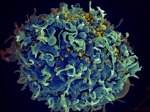
This scanning electron micrograph shows HIV particles (colored yellow) infecting a human T cell. Image: National Institute of Allergy and Infectious Diseases, National Institutes of Health
In 2006, an HIV-positive man was diagnosed with leukemia. First he received chemotherapy, and when the cancer returned his doctor recommended a stem-cell transplant with tissues obtained from a bone-marrow donor. After finding an unusually high number of compatible donors, his doctor, Gero Hütter, had a simple idea that would change the course of HIV research. Dr. Hütter knew of a rare genetic mutation that confers immunity to many strains of HIV, including the strain that infected his cancer patient. And new blood cells, including immune cells, are manufactured by bone marrow. What if he could find a bone-marrow donor with this mutation? What effect would it have on the HIV infection?
Five years after his cancer diagnosis, the man, known as the Berlin patient and recently identified as Timothy Ray Brown, is in remission from cancer … and the most sensitive tests have been unable to detect HIV anywhere in his body, despite the discontinuation of antiretroviral drugs. Scientists are a cautious lot, careful not to make grand statements without qualifying them with words like “seem” and “suggest.” But more and more, researchers are starting to say that Brown could be the first case in which a cure for HIV was attained.
Human immunodeficiency virus, or HIV, has been the focus of intense research since the 1980s, when it was identified as the causative agent of AIDS. Many anti-HIV drugs have been developed since then, though worldwide, less than a third of people who need the drugs have access to them. Those with access, however, have significantly improved health outcomes and longer life expectancy. Continue reading
